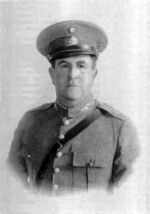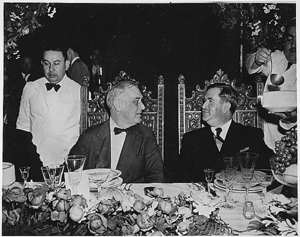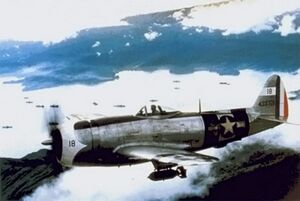مانويل أڤيلا كماتشو
| مانويل أڤيلا كماتشو Manuel Ávila Camacho | |
|---|---|
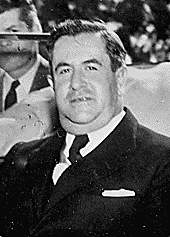
| |
| رئيس المكسيك رقم 52 | |
| في المنصب December 1, 1940 – November 30, 1946 | |
| سبقه | لازارو كاردناس |
| خلفه | ميگل ألـِمان |
| Secretary of National Defense of Mexico | |
| في المنصب 18 October 1936 – 31 January 1939 | |
| الرئيس | Lázaro Cárdenas |
| سبقه | Andrés Figueroa |
| خلفه | Jesús Agustín Castro |
| تفاصيل شخصية | |
| وُلِد | أبريل 24, 1897 تزيوتلان، پويبلا |
| توفي | أكتوبر 13, 1955 (aged 58) ولاية مهيكو |
| المدفن | Panteón Francés |
| القومية | مكسيكي |
| الحزب | الحزب الثوري المؤسساتي |
| الزوج | Soledad Orozco |
| الخدمة العسكرية | |
| الخدمة/الفرع | |
| سنوات الخدمة | 1914–1933 |
| الرتبة | Brigadier General |
مانويل أڤيلا كماتشو Manuel Ávila Camacho (عاش 1897-1955م). جندي ودبلوماسي وزعيم سياسي مكسيكي، أصبح رئيس جمهورية المكسيك من عام 1940-1946م. وقد واصل بوصفه رئيسًا للجمهورية، التدابير الإصلاحية التي أدخلها لازارو كاردناس. انظر: كاردناس، لازارو. ولكن أفيلا كاماكو أدخل إلى الحياة الوطنية طابعًا أكثر محافظة. وخلال الحرب العالمية الثانية (1939-1945م) حث الشعوب الأمريكية ـ اللاتينية على معارضة دول المحور.
ولد أفيلا كاماكو في تزيوتلان، پويبلا بالمكسيك. وفي سن السابعة عشرة، انضم إلى الانتفاضة التي قادها فينوستيانو كارانزا ضد رئيس الجمهورية، فيكتوريانو هويرتا. وحارب فيما بعد مع كاردناس وبلوتاركو إيلياس كاليس ضد تمرد أدولفو دولاهويرتا في عام 1923م.
النشأة
Manuel Ávila was born in Teziutlán, a small but economically important town in Puebla, to middle-class parents, Manuel Ávila Castillo and Eufrosina Camacho Bello.[1] His older brother, Maximino Ávila Camacho, was a more dominant personality. There were several other siblings, among them a sister, María Jovita Ávila Camacho, and several brothers. Two of his brothers, Maximino Ávila Camacho and Rafael Ávila Camacho, served as governors of Puebla.
Manuel Ávila Camacho did not receive a university degree although he studied at the National Preparatory School.
بداية السيرة العملية
He joined the revolutionary army in 1914 as a second lieutenant and reached the rank of colonel by 1920. The same year, he served as the chief of staff of the state of Michoacán under Lázaro Cárdenas and became his close friend. He opposed the 1923 rebellion of former revolutionary general Adolfo de la Huerta.[2] In 1929, he fought under General Cárdenas against the Escobar Rebellion, the last serious military rebellion of disgruntled revolutionary generals, and the same year, he achieved the rank of brigadier general.
He was married to Soledad Orozco García (1904–1996), who was born in Zapopan, Jalisco, and was a member of a prominent family in Jalisco.
After his military service, Ávila Camacho entered the public arena in 1933 as the executive officer of the Secretariat of National Defense and became Secretary of National Defense in 1937. In 1940, he was elected president of Mexico after he had been nominated to represent the party that later became the Institutional Revolutionary Party.
Camacho won the controversial presidential election over right-wing candidate and revolutionary-era General Juan Andreu Almazán.
الرئاسة
End of conflict between church and state
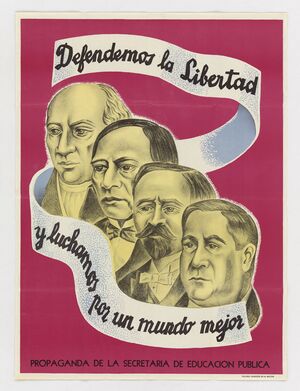
Camacho, a professed Catholic, said, "I am a believer." Since the revolution, all presidents had been anticlerical.[3] During Camacho's term, the conflict between the Roman Catholic Church in Mexico and the Mexican government largely ended.
السياسات الداخلية
He protected the working class by creating the Mexican Social Security Institute (IMSS) in 1943. He worked to reduce illiteracy, continued land reform, and declared a rent freeze to benefit low-income citizens.
He promoted election reform and passed a new electoral law passed in 1946 to make it difficult for opposition parties of the far right and the far left to operate legally. The law established the following criteria that had to be fulfilled by any political organization to be recognized as a political party:
- have at least 10,000 active members in 10 states;
- exist for at least three years before elections;
- agree with the principles established in the constitution;
- not form alliances or be subordinated to international organizations or foreign political parties.[4]
On 18 January 1946, he had the Party of the Mexican Revolution (PRM) renamed to the Institutional Revolutionary Party (PRI), its current name. The Mexican army had been a sector of the PRM, but it was eliminated from the organization of the PRI.[5]
Economically, he pursued the country's industrialization, which benefited only a small group, and income inequality increased.[6] World War II stimulated Mexican industry, which grew by approximately 10% annually between 1940 and 1945, and Mexican raw materials fueled the US war industry.[7]
In agriculture, his administration invited the Rockefeller Foundation to introduce Green Revolution technology to bolster Mexico's agricultural productivity.[8]
In education, Camacho reversed Lázaro Cárdenas's policy of socialist education in Mexico and had the constitutional amendments that mandated it repealed.[9]
وحظي أفيلا كاماكو بالتقدير لدفاعه عن موريليا في عام 1927م. وفي عام 1929م تفاوض أفيلا كاماكو بشأن استسلام 12 من الجنرالات المتمردين وعمل وزيرًا للدفاع الوطني تحت حكم كاردناس.
السياسة الخارجية
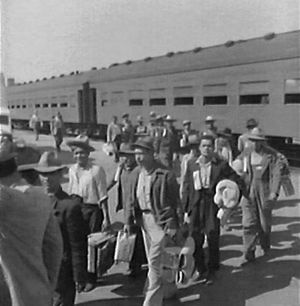
During his term, Camacho faced the difficulty of governing during World War II. After two of Mexico's ships (Potrero del Llano and Faja de Oro) carrying oil were destroyed by German submarines in the Gulf of Mexico,[10] Camacho declared war against the Axis powers on 22 May 1942. Mexican participation in World War II was mainly limited to an airborne squadron, the 201st (Escuadrón 201), to fight the Japanese in the Pacific. The squadron consisted of 300 men, and after receiving training in Texas, it was sent to the Philippines on 27 March 1945. On 7 June 1945, its missions started, and the squadron participated in the Battle of Luzon. By the end of the war, 5 Mexican soldiers had lost their lives in combat. Despite its short participation in the war, Mexico belonged to the victorious nations and had thus gained the right to participate in the postwar international conferences.[11]
Mexico's joining the conflict on the side of the Allies improved relations with the United States. Mexico provided both raw material for the conflict and also 300,000 guest workers under the Bracero program to replace some of the Americans who had left to fight in the war. Mexico also resumed diplomatic relations with the United Kingdom and the Soviet Union, which had been broken off during the presidency of Lázaro Cárdenas.[بحاجة لمصدر] In 1945, Mexico signed the United Nations Charter, and in 1946, it became the headquarters of the Inter-American Conference about War and Peace.[بحاجة لمصدر]
Conflicts with the United States, which had existed in the decades before his presidency, were resolved. Especially in the early years of World War II, Mexican-American relations were excellent. The United States provided Mexico with financial aid for improvements on the railway system and the construction of the Pan American Highway. Moreover, the Mexican foreign debt was reduced.[12]
المصادر
| Manuel Ávila Camacho
]].- Online biography
- Camp, Roderic A. Mexican Political Biographies. Tucson, Arizona: University of Arizona, 1982.
- ^ LaFrance, David G. "Manuel Ávila Camacho" in Encyclopedia of Mexico, Chicago: Fitzroy Dearborn 1997, p. 116.
- ^ Camp, "Manuel Avila Camacho", p. 244.
- ^ Tuck, Jim. "Mexico's marxist guru: Vicente Lombardo Toledano (1894–1968)". Mexconnect. 9 October 2008.
- ^ Delgado de Cantú, Gloria M. (2003). Historia de México II. Pearson Educación. p. 250.
- ^ Cline, Howard F. Mexico, 1940-1960: Revolution to Evolution. New York: Oxford University Press 1963, p. 153.
- ^ Beezley, William (2010). The Oxford History of Mexico. Oxford University Press. p. 501.
- ^ Beezley, William (2010). The Oxford History of Mexico. Oxford University Press. p. 500.
- ^ Cotter, Joseph. Troubled Harvest: Agronomy and Revolution in Mexico 1880-2002. Westport CT: Prager 2003.
- ^ Camp, "Manuel Avila Camacho," p. 244.
- ^ "Faja de Oro". Retrieved 17 November 2013.
- ^ Delgado de Cantú, Gloria M. (2003). Historia de México II. Pearson Educación. pp. 257–258.
- ^ Beezley, William (2010). The Oxford History of Mexico. Oxford University Press. p. 537.
- Short description is different from Wikidata
- Articles with hatnote templates targeting a nonexistent page
- Missing redirects
- Articles with unsourced statements from January 2015
- رؤساء المكسيك
- Mexican presidential candidates (1940)
- أعضاء الحزب الثوري المؤسساتي
- زعماء سياسيون في الحرب العالمية الثانية
- جنرالات مكسيكيون
- People from Puebla
- مواليد 1897
- وفيات 1955
